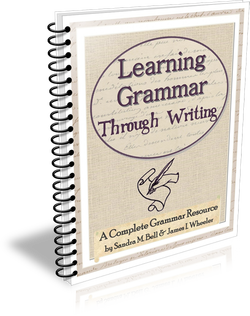Learning Grammar Through Writing serves as a self-correcting tool for students who have already learned foundational grammar and should be applying what they know in their composition work.
This book contains grammar and composition rules and examples with reference numbers. When students write a composition, rather than correcting student work, parents mark the number of the rule that has been violated such as “8e.” The student might recognize his or her error without looking it up, but if not, the student looks up “8e” where the book states the rule: “Avoid unnecessary words.” Examples then show a “wordy” sentence and a “less-wordy” option. This method of correction forces students to process how each particular rule applies to their own writing in a much more effective way than do either unrelated grammar exercises or compositions with corrections supplied by the teacher.
The book has both a table of contents and an index, so parents can look up errors relatively quickly. Nevertheless, the more familiar parents become with the book, the more readily and easily they will be able to apply the method. Of course, parents have to be able to spot the errors in the first place.
Learning Grammar Through Writing can be used for third through twelfth grades, although I do not think it is detailed enough for most high school students. It covers the basics of grammar and punctuation but skips some of the “fine tuning” details that we find in more extensive grammar handbooks or reference works. I think it is most useful for students in the middle to upper elementary grades, and maybe up into junior high.
The original version of this book went out of print some years ago. Cascia Books has obtained permission to reprint it. They have added appendices with a chart of punctuation rules, syllabication rules, “More Problem Words and Phrases,” “Various Concepts” which includes additional rules and examples that will be helpful for older students, and a list of suggestions for curing writer’s block.
The only thing I spotted that reveals its origin a few decades ago is section 12 on addressing envelopes and writing the inside address. The book continues to spell out the full name of states while the post office requires abbreviations. On the positive side, the new edition sports a metal comb binding and is a sturdier book than the original.
The original edition of this book was very popular among homeschoolers following Ruth Beechick’s approach to education. Present-day homeschoolers are finding it especially useful for those following Charlotte Mason’s methodology. However, this is an efficient way to review grammar concepts as needed for any student no matter what educational approaches you are using.
Cascia Books also publishes Lighted Lanterns: A Catholic Language Arts Program. While only younger grade levels of that program are available thus far, I can see how Learning Grammar Through Writing should work very well with those courses. While Lighted Lanterns is a Catholic program Learning Grammar Through Writing is secular.









